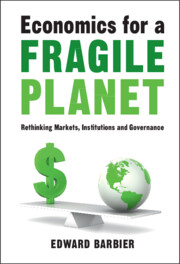Book contents
- Economics for a Fragile Planet
- Economics for a Fragile Planet
- Copyright page
- Dedication
- Contents
- Figures
- Tables
- Preface
- Acknowledgments
- 1 Introduction
- 2 Humankind and the Planet
- 3 Economics for a Fragile Planet
- 4 Climate Change
- 5 Land Use Change and Biodiversity
- 6 Freshwater
- 7 Oceans and Coasts
- 8 Public Policies
- 9 Business
- 10 Conclusion
- References
- Index
9 - Business
Published online by Cambridge University Press: 24 March 2022
- Economics for a Fragile Planet
- Economics for a Fragile Planet
- Copyright page
- Dedication
- Contents
- Figures
- Tables
- Preface
- Acknowledgments
- 1 Introduction
- 2 Humankind and the Planet
- 3 Economics for a Fragile Planet
- 4 Climate Change
- 5 Land Use Change and Biodiversity
- 6 Freshwater
- 7 Oceans and Coasts
- 8 Public Policies
- 9 Business
- 10 Conclusion
- References
- Index
Summary
Chapter 9 examines the evidence of growing adoption and initiatives by corporations, businesses and the financial system to incorporate actions to mitigate environmental risks and improve the global environment, and look in particular at the possibility of private sector action to move toward better environmental stewardship. Firms increasingly find that improved environmental performance reduces their overall cost of capital and their attractiveness to potential investors. However, better environmental scarcity and risk management by firms requires a range of complementary policies for green financing and investment; ending the underpricing of nature; and taxing major biosphere exploiters. Corporations that are willing to become biosphere stewards should also collaborate with governments in collective action to address global environmental risks.
Keywords
- Type
- Chapter
- Information
- Economics for a Fragile PlanetRethinking Markets, Institutions and Governance, pp. 246 - 275Publisher: Cambridge University PressPrint publication year: 2022

